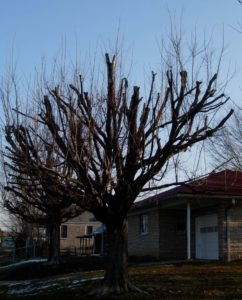
Topping leads to numerous upright, weak branches.
Photo Credit: Mary Welch-Keesey, retired Purdue Extension Specialist
Topping a tree is an all-too-common practice among homeowners, particularly when their trees become too tall and pose a possible threat to the house or overhead power lines. Some have the trees topped because they believe, or are led to believe, that topping is a good pruning practice.
Some situations obviously require the removal of large limbs for the sake of safety. But topping is a drastic step that ultimately endangers the tree’s life. Removing such a great quantity of growth in one shot throws off the roots-to-shoots balance that the tree has gradually developed all those years. The much-reduced leaf surface will not be able to manufacture sufficient food reserves to feed the large root system. As roots starve, the rest of the tree will suffer from insufficient moisture and nutrients.
Another drawback to topping for many tree species is the stimulation of numerous, upright branches that grow straight up. These shoots are typically very soft, weak growth that breaks easily and is more susceptible to attack by diseases and insects. These shoots are rapid growers, so the tree will soon be back to and exceed its original height.
Stubs left by the topping are usually too large for the tree’s defense process of callusing to seal the wound. Thus, stubs also become easy prey for insects, diseases and decay, and large stubs drastically disfigure the tree’s natural beauty.
There are alternatives to topping when size reduction is required. Thinning out the canopy by removing selected branches completely back to their point of origin will reduce the tree’s size while maintaining more of its natural shape. Cuts will be less conspicuous and should heal more rapidly. Thinning is a more time-consuming process that requires a more skilled hand, which usually translates to higher expense. In many cases, you’ll need to hire a professional arborist to safely and correctly complete the job.
If the tree isn’t worth the investment to do the job correctly, it’s probably better to remove the tree entirely rather than top repeatedly. In the case of overhead power lines, it really is best to remove the tree and start over with a more appropriately sized plant. But if the tree is worth saving, make the right investment in a healthy future.
For more information on proper pruning techniques, see the following Purdue publications.
Pruning Ornamental Trees and Shrubs
https://www.extension.purdue.edu/extmedia/HO/HO-4-W.pdf
Why Hire an Arborist
https://www.extension.purdue.edu/extmedia/FNR/FNR-FAQ-13-W.pdf
What’s Wrong With Topping Trees
http://www.extension.purdue.edu/extmedia/FNR/FNR-FAQ-14-W.pdf
Tree Pruning Essentials
https://extension.purdue.edu/extmedia/FNR/FNR-506-W.pdf